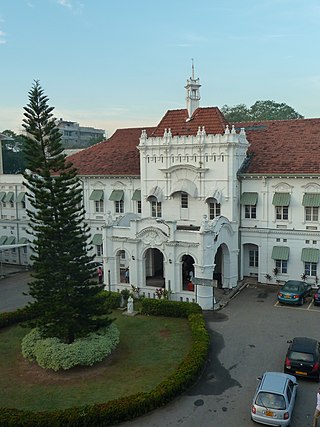
Sinnathamby Sivamaharajah was a Sri Lankan Tamil newspaper publisher, politician and Member of Parliament.

The Sri Lanka Army Medical Corps (SLAMC) (Sinhala: ශ්රී ලංකා යුද හමුදා වෛද්ය බලකාය Shri Lanka Yuddha Hamuda Vayidya Balakaya) is a specialist corps in the Sri Lanka Army which specializes in military medicine and provides medical services to all army personnel and their families in war and in peace. It is made up of 4 regular units and one volunteer unit. Headquartered in Colombo, formally at army headquarters. The corps Cap badge depicting the Rod of Asclepius. General officers and senior officers of the SLMC wear gorget patches of maroon rather than of scarlet worn by other officers of similar rank.

Union College is a provincial school in Tellippalai, Sri Lanka. Founded in 1816 by American Ceylon Mission, it is one of Sri Lanka's oldest schools.

Cathiravelu Sittampalam was a Ceylon Tamil civil servant, politician, Member of Parliament and government minister.
Tellippalai or Thellippalai also known as Tillypalli (தில்லைப்பள்ளி) is a small town in the northern Jaffna District of Sri Lanka. It is located about 15 kilometers north of Jaffna town along the Kankesanthurai road

The Jaffna hospital massacre occurred on October 21 and 22, 1987, during the Sri Lankan Civil War, when troops of the Indian Peace Keeping Force entered the premises of the Jaffna Teaching Hospital in Jaffna, Sri Lanka, an island nation in South Asia, and killed between 60 and 70 patients and staff. The rebel Liberation Tigers of Tamil Eelam, the government of Sri Lanka, and independent observers such as the University Teachers for Human Rights and others have called it a massacre of civilians.

Jaffna Teaching Hospital is a government hospital in Jaffna, Sri Lanka. It is the leading hospital in the Northern Province and the only hospital in the province controlled by the central government in Colombo. The hospital is the only teaching hospital in the Northern Province. The hospital is the main clinical teaching facility for the University of Jaffna's Faculty of Medicine. As of 2010 it had 1,228 beds.

Sri Lanka has a free and universal health care system. It scores higher than the regional average in healthcare having a high Life expectancy and a lower maternal and infant death rate than its neighbors. It is known for having one of the world's earliest known healthcare systems and has its own indigenous medicine system.

Vavuniya Hospital is a government hospital in Vavuniya, Sri Lanka. It is the leading hospital in Vavuniya District and is controlled by the provincial government in Jaffna. As of 2010 it had 624 beds. The hospital is sometimes called Vavuniya General Hospital or Vavuniya District General Hospital.
Mannar Hospital is a government hospital in Mannar, Sri Lanka. It is the leading hospital in Mannar District and is controlled by the provincial government in Jaffna. As of 2010 it had 350 beds. The hospital is sometimes called Mannar District General Hospital or Mannar Base Hospital.
Mullaitivu Hospital is a government hospital in Mullaitivu, Sri Lanka. It is the leading hospital in Mullaitivu District and is controlled by the provincial government in Jaffna. As of 2010 it had 256 beds. The hospital is sometimes called Mullaitivu District General Hospital or Mullaitivu District Hospital.
Point Pedro Hospital is a government hospital in Point Pedro, Sri Lanka. It is controlled by the provincial government in Jaffna. As of 2010 it had 264 beds. The hospital is sometimes called Point Pedro Base Hospital.
Chavakachcheri Hospital is a government hospital in Chavakachcheri, Sri Lanka. It is controlled by the provincial government in Jaffna. As of 2010 it had 111 beds. The hospital is sometimes called Chavakachcheri Base Hospital or Chavakachcheri District Hospital.
Kayts Hospital is a government hospital in Kayts, Sri Lanka. It is controlled by the provincial government in Jaffna. As of 2010 it had 59 beds. The hospital is sometimes called Kayts Base Hospital or Kayts District Hospital.
Cheddikulam Hospital is a government hospital in Cheddikulam, Sri Lanka. It is controlled by the provincial government in Jaffna. As of 2010 it had 425 beds. The hospital is sometimes called Cheddikulam Base Hospital or Cheddikulam District Hospital.
Mallavi Hospital is a government hospital in Mallavi, Sri Lanka. It is controlled by the provincial government in Jaffna. As of 2010 it had 144 beds. The hospital is sometimes called Mallavi Peripheral Unit or Mallavi District Hospital.
Coomarasamy Balasingham was a leading Ceylon Tamil civil servant.
Varuthalaivilan is a small town or village in the northern Jaffna District of Sri Lanka.

The National Hospital of Sri Lanka is a government hospital in Colombo, Sri Lanka. Founded in 1864 as the General Hospital, it is the leading hospital in Sri Lanka and is controlled by the central government. The hospital has 18 intensive care units and 21 operating theaters and 3,404 beds. It employs 7,500 staff of which 1,500 are doctors. The hospital carries out 5,000 major and minor surgeries each month and treats over two million out patients a year. Situated on a 36-acre site, it includes the Dental Institute, Maligawatte Kidney Hospital, Nurse's Training School, Post Basic Nurse's Training School, School of Eco Cardiograph, School of Physiotherapy, School of Radiography and the University of Colombo's Faculty of Medicine.









